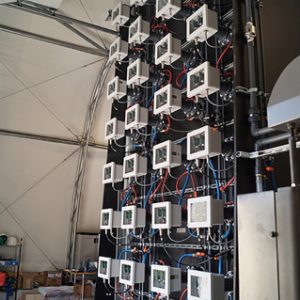St Marys Cement, a Votorantim Cimentos company, is taking part in a demonstration project that reveals how carbon dioxide waste can fuel the production of valuable raw materials.
 |
| The 25,000-litre photobioreactor at St Marys Cement. |
The key to this process is algae and the project, which is Canada’s first algal biorefinery demonstration pilot, was recently showcased during an open house at St Marys cement plant in St Mary’s, Ontario.
The project represents a broad collaboration among clean tech scientists, the Canadian government and sustainability experts at St Marys Cement. The unique technologies that drive the project come from Pond Technologies, an algae production company based in Markham, Ontario. Extensive technical support and resources also come from Canada’s National Research Council through its Algal Carbon Conversion Program. St Marys provides the environment and raw materials to help test and advance this innovative technology.
Untreated emissions coming directly from the kiln smokestack at the St Marys cement plant are channeled into a custom photobioreactor developed by the Pond team. Fast-growing algae inside the reactor consume the gases, creating tons of biomass in the process.
“We as a species produce more carbon dioxide than anything else,” noted Steve Martin, CEO and founder of Pond Technologies. “With algal conversion technology, we now have a way of harnessing this waste product to create new resources.”
Though algae from the project are currently used for NRC studies, they may someday be used to produce valuable products ranging from bio-fuel and animal feeds to soil amendments, pharmaceuticals and nutritional supplements.
The purpose of the $4-million, 1,500-sq.-ft. plant is to demonstrate the technology’s overall potential – an essential step in the development of bigger solutions, said Martin.
How it Works
Pond Technologies’ proprietary process uses advanced photobioreactors that produce the light filled, CO2-rich conditions in which algae thrive. The light comes from custom-designed, high-intensity lights that flash continuously.
The flashing tricks the algae into thinking the days are very short, triggering rapid growth, Martin explained.
“Algae grow like any other organism, just at a tremendous rate – upwards of four to eight generations a day,” he said. “Our process is specially designed to harness algae’s growth potential to produce high volumes of biomass.”
To maximize growth, Pond Technologies’ bioreactor uses uniquely designed LED lights that literally outshine the sun.
“Ordinary sunlight can only penetrate the algae medium – the water-to-algae mix – at a depth of 2 cm,” Martin explained. “By contrast, our bioreactor achieves 30 to 40 cm of penetration, yielding denser growth in the smallest footprint of any comparable bioreactor.”
Continuous harvesting of the algae is also essential in maximizing biomass output. In a relatively small bioreactor such as the one at St Marys, which holds 25,000 liters of algae medium, the organisms are harvested at a rate equal to their growth, “tricking them into thinking they’re in a much larger tank,” Martin said.
Scaling up
“Though modest in scale, the St Marys pilot project points to solutions that may soon have major global impact,” said Bill Asselstine, vice-president, technical, safety and sustainability for Votorantim Cimentos’ North American operations.
“This collaboration with Pond Technologies and the National Research Council of Canada advances our goals of product innovation and sustainable development, while strengthening our position as a leader in the building materials sector,” said Asselstine, adding that “The project is consistent with our expressed purpose as a company – life is made to last – which speaks to the longevity or our products and our commitment to having a positive, long-term impact on people and our planet.”
Reducers cool and equalize pressure of unfiltered gases on their way to the bioreactor.
While the current project utilizes about 1 percent of all CO2 produced on-site, plans to scale the technology are already underway.
The next step: a proposed larger, commercial-scale facility at St Marys Bowmanville cement plant, 45 minutes from Toronto. This project would draw a greater percentage of carbon emissions from the flue stream, testing an on-site process that would dry and pelletize the biomass produced to create animal feed.
Up to 40 percent of the project’s build-out may be covered as part of a $74-million clean tech innovation initiative sponsored by the Ontario Centres of Excellence.

